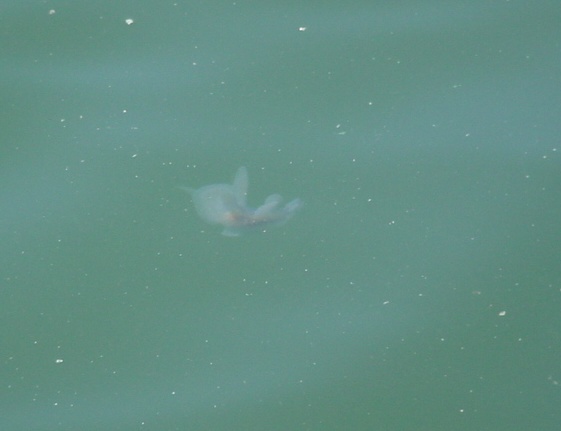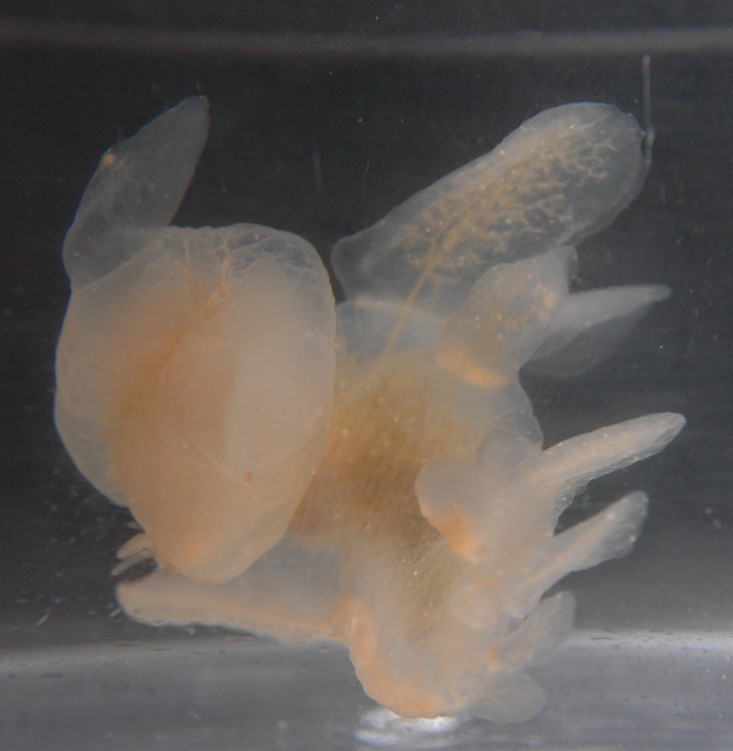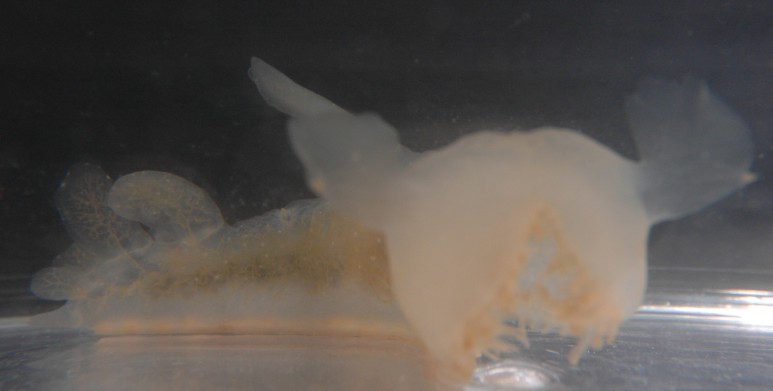Melibe leonina (Gould, 1853)Common name(s): Lion nudibranch |
|
| Synonyms: Chioraera leonina, Chioraera dalli |  |
| Phylum Mollusca
Class Gastropoda Subclass Opisthobranchia Order Nudibranchia Suborder Dendronotacea Family Tethyidae |
|
| Melibe leonina about 10 cm long. Collected from eelgrass at Padilla Bay. The head and oral hood is to the right. Some of the tentacles from the opening in the oral hood can be seen. | |
| (Photo by: Dave Cowles July 2006) | |
How to Distinguish from Similar Species: This is the only local Dendronotacean with a huge oral hood
Geographical Range: Kodiak Island, Alaska to Gulf of California, Mexico. Mostly offshore in kelp beds south of Puget Sound
Depth Range: Low intertidal to 37 m
Habitat: Eelgrass beds, kelp (especially Macrocystis) beds, harbors
Biology/Natural History: This nudibranch is unusual in several ways. It lacks a radula, but its oral veil is expanded hugely into a hood which it extends ahead of itself and uses to trap small crustaceans and other prey. Its diet includes copepods, amphipods, and ostracods, as well as small post-larval mollusks. The animal stands attached to the substrate (often a blade of eelgrass) and expands the oral hood. It then sweeps the hood left and right or downward (photo). When the ventral surface of the hood contacts a small animal the hood rapidly closes and the fringing tentacles overlap, holding the prey in. The whole animal is then forced into the nudibranch's mouth. Predators include the kelp crab Pugettia producta. Pycnopodia helianthoides is repelled from contact. The polychaete scaleworm Halosydna brevisetosa is sometimes a symbiont, feeding on fecal pellets. Some may have symbiotic algae.
Branches of the gut extend out into the cerata. The name is due to the large hood which may look like a lion's mane.
This species hunts mainly attached, but is a good swimmer (movie). When swimming it is usually upside-down, and thrashes or undulates back and forth. It is often seen swimming near the water's surface in the summer (movie), or after fall and winter storms disturb the eelgrass. Eggs are laid in long, wide yellow or cream-colored ribbons in the summer, which are attached to kelp and eelgrass. The ribbons form tight coils or wavy folds. Eggs can be found in the Washington area at any season. They appear to live about one year, reciprocally fertilize one another (as with most nudibranchs they are hermaphrodites), lay their eggs and die. This species has been used for neurological research.
According to Baltzley et al., (2011), many gastropods, including this species, have a special network of pedal ganglia in their foot which assists in crawling. The two main neurons involved produce pedal peptides which elicit an increase in the rate of beating of cilia on the foot, resulting in crawling.
| Return to: | |||
| Main Page | Alphabetic Index | Systematic Index | Glossary |
References:
Dichotomous Keys:Kozloff 1987, 1996
Smith and Carlton, 1975
General References:
Behrens,
1991
Harbo,
1999
Johnson
and Snook, 1955
Kozloff,
1993
Morris
et al., 1980
Niesen,
1997
O'Clair
and O'Clair, 1998
Ricketts
et al., 1985
Wrobel
and Mills, 1998
Scientific Articles:
Baltzley,
Michael J., Allison Serman, Shaun D. Cain, and Kenneth J. Lohmann, 2011.
Conservation of a Tritonia
pedal peptides network in gastropods. Invertebrate Biology
130: 4 pp. 313-324
Lee, Colin Anthony, and Winsor Hays Watson, 2022. "In the sea slug Melibe leonina the posterior nerves communicate stomach distention to inhibit feeding and modify oral hood movements." Frontiers in physiology 13: 1047106.
Web sites:
General Notes and Observations: Locations, abundances, unusual behaviors:
Click here for a short closeup video of this species swimming in a tank

Melibe leonina swimming near surface, about 3 m from
the bottom,
in a harbor. Length about 8 cm Click the photo for
a short
video of this individual swimming
Click here for a movie of another individual swimming in a planktonkreisel (Dave Cowles, 2018)

This is a top left view of a swimming individual, who has been swimming
away but is making a strong turn to the left. The head and
oral hood
are visible to the right.
The flaplike extensions of the oral hood are the rhinophores.
The large dorsal cerata
with an internal network of vessels (hepatic diverticula?) are visible
at the top and right. The foot is facing down and away from
view.
The oral hood is closed in this view.

In this nearly head-on view the open oral hood with its filiform
tentacles can be seen.

This cluster of eggs, about 2.5 cm across, was laid attached to a wall of a planktonkreisel by Melibe leonina. Photo by Dave Cowles, July 2018
Authors and Editors of Page:
Dave Cowles (2005): Created original page